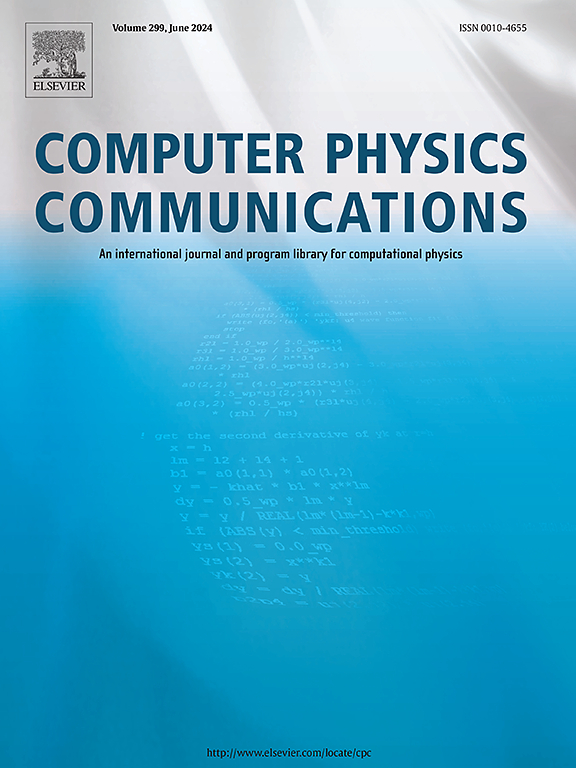聚合物模拟中的智能交联:SuSi的复杂3D网络方法
IF 3.4
2区 物理与天体物理
Q1 COMPUTER SCIENCE, INTERDISCIPLINARY APPLICATIONS
引用次数: 0
摘要
交联聚合物由于其机械强度、耐化学性和热稳定性,在材料科学中起着至关重要的作用,使其在生物医学设备、涂料和电子产品中具有不可宝贵的价值。然而,由于其复杂的交联网络,构建这些系统的现实分子模型仍然是一个挑战。本研究介绍了SuSi,一个基于python的程序,用于生成用于分子模拟的线性和交联聚合物系统。SuSi采用人工智能树搜索算法优化交联过程,确保高效无碰撞的网络形成。该程序与AMBER力场兼容,并支持各种聚合物结构,包括均聚物、嵌段共聚物和复杂的3d网络结构。为了证明它的能力,SuSi被用来生成三种不同的交联体系:硅烷-交联聚乙烯(Si-XLPE),热敏聚(NIPAAm-co-MBA),以及由苯丙氨酸、丁烯二醇和富马酸酯组成的复合不饱和聚酯酰胺水凝胶,与聚乙二醇(UPEA-PEG)交联。生成的结构被成功地参数化用于分子动力学模拟,并通过实验观察结果进行验证,表明SuSi是精确建模复杂聚合物体系和推进聚合物模拟的通用工具。本文章由计算机程序翻译,如有差异,请以英文原文为准。
Intelligent cross-linking in polymer simulations: SuSi’s approach to complex 3D networks
Cross-linked polymers play a vital role in the materials science due to their mechanical strength, chemical resistance, and thermal stability, making them invaluable in biomedical devices, coatings, and electronics. However, constructing realistic molecular models of these systems remains a challenge due to their complex cross-linked networks. This study introduces SuSi, a Python-based program designed to generate both linear and cross-linked polymer systems for molecular simulations. SuSi uses artificial intelligence tree search algorithms to optimize the cross-linking process, ensuring efficient and collision-free network formation. The program is compatible with the AMBER force field and supports a wide variety of polymer architectures, including homopolymers, block copolymers, and complex 3D-network structures. To demonstrate its capabilities, SuSi was employed to generate three distinct cross-linked systems: silane-cross-linked polyethylene (Si-XLPE), thermosensitive poly(NIPAAm-co-MBA), and the complex unsaturated polyesteramide hydrogel made of phenylalanine, butenediol, and fumarate, cross-linked with polyethylene glycol (UPEA-PEG). The generated structures were successfully parametrized for molecular dynamics simulations and validated through experimental observables, showing that SuSi is a versatile tool for accurately modeling complex polymeric systems and advancing polymer simulations.
求助全文
通过发布文献求助,成功后即可免费获取论文全文。
去求助
来源期刊

Computer Physics Communications
物理-计算机:跨学科应用
CiteScore
12.10
自引率
3.20%
发文量
287
审稿时长
5.3 months
期刊介绍:
The focus of CPC is on contemporary computational methods and techniques and their implementation, the effectiveness of which will normally be evidenced by the author(s) within the context of a substantive problem in physics. Within this setting CPC publishes two types of paper.
Computer Programs in Physics (CPiP)
These papers describe significant computer programs to be archived in the CPC Program Library which is held in the Mendeley Data repository. The submitted software must be covered by an approved open source licence. Papers and associated computer programs that address a problem of contemporary interest in physics that cannot be solved by current software are particularly encouraged.
Computational Physics Papers (CP)
These are research papers in, but are not limited to, the following themes across computational physics and related disciplines.
mathematical and numerical methods and algorithms;
computational models including those associated with the design, control and analysis of experiments; and
algebraic computation.
Each will normally include software implementation and performance details. The software implementation should, ideally, be available via GitHub, Zenodo or an institutional repository.In addition, research papers on the impact of advanced computer architecture and special purpose computers on computing in the physical sciences and software topics related to, and of importance in, the physical sciences may be considered.
 求助内容:
求助内容: 应助结果提醒方式:
应助结果提醒方式:


